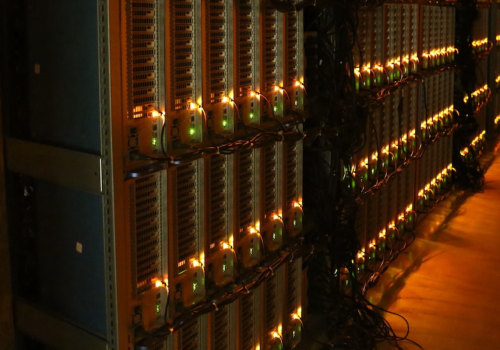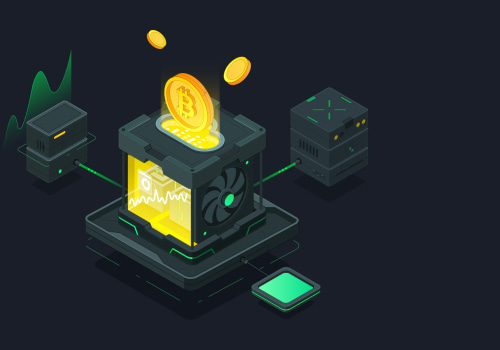Cryptocurrency Mining) The competitive process that verifies and adds new transactions to the blockchain for a cryptocurrency that uses the proof-of-work (PoW) method. Bitcoin mining is the process by which new bitcoins come into circulation. It is also how the network confirms new transactions and is a critical component of the maintenance and development of the blockchain ledger. Mining is carried out using sophisticated hardware that solves an extremely complex computational mathematical problem.
The first computer to find the solution to the problem receives the next block of bitcoins and the process starts again. Only 1 megabyte of transaction data can fit in a single bitcoin block. The 1 MB limit was set by Satoshi Nakamoto, and this has become a matter of controversy because some miners believe that the block size should increase to accommodate more data, which would mean that the Bitcoin network could process and verify transactions more quickly. Let's say I tell three friends that I'm thinking of a number between one and 100, and I write that number on a piece of paper and stamp it on an envelope.
My friends don't have to guess the exact number; they just have to be the first person to guess any number that is less than or equal to it. And there's no limit to the amount of guesswork they get. In terms of Bitcoin, simultaneous responses happen frequently, but at the end of the day, there can only be one winning answer. When multiple simultaneous responses are presented that are equal to or less than the target number, the Bitcoin network will decide by simple majority (51%) which miner to honor.
As you can see here, their contribution to the Bitcoin community is that they confirmed 1,768 transactions for this block. If you really want to see all 1,768 transactions in this block, go to this page and scroll down to the Transactions section. Participants with a small percentage of the mining power have very little chance of discovering the next block on their own. For example, a mining card that could be purchased for a couple of thousand dollars would represent less than 0.001% of the network's mining power.
With such a small chance of finding the next block, it could be a long time before the miner finds a block, and the difficulty of climbing makes matters even worse. The miner may never recover his investment. The answer to this problem is mining pools. As mentioned earlier, the easiest way to acquire Bitcoin is to simply buy it on one of the many Bitcoin exchanges.
Alternatively, you can always take advantage of the peak strategy. This is based on the old mountain range that during the California gold rush of 1849, the smart investment was not to look for gold, but to have the spikes used for mining. Bitcoin mining is the process of creating new bitcoins by solving puzzles. It consists of computer systems equipped with specialized chips that compete to solve mathematical puzzles.
The first bitcoin miner (as these systems are called) to solve the puzzle is rewarded with bitcoin. The mining process also confirms transactions on the cryptocurrency network and makes them reliable. Bitcoin mining is a way for people to earn new Bitcoins by performing the process of validating Bitcoin transactions. Every miner who validates a block of transactions is rewarded with a certain amount of Bitcoin.
In other words, it is a dual process that generates new coins and allows coins in circulation to be used safely. Bitcoin mining is a computational process that achieves two distinct and important objectives. First, it allows miners to “find new bitcoins that are added to circulation. Second, bitcoin miners verify transactions while mining.
This helps ensure the integrity of the blockchain, which serves as a transaction log. Geared to mining the second largest cryptocurrency, Ethermine, its predecessor Ethpool, includes more than 125,000 miners who control more than a quarter of the hash rate of the ETH network. EasyMiner is an open source cryptomining software optimized for the popular x86 and x86—64 architecture and compatible with getwork protocols (JSON-RPC) and stratum mining. If you want to estimate how much bitcoin you could mine with the hash rate of your mining platform, the CryptoCompare site offers a useful calculator.
Features such as load balancing, mining the most cost-effective cryptocurrency and setting policies for mining are available at the discretion of the administrator. Bitcoin and many other cryptocurrencies use the proof-of-work strategy to achieve these verifications. Beyond launching new coins into circulation, mining is critical to the security of Bitcoin (and many other cryptocurrencies). But they began to take a long time to discover transactions on the cryptocurrency network as the difficulty level of the algorithm increased over time.
While mining is a resource-depleting process, gambling requires maintaining the cryptocurrency for an extended period of time to earn block rewards. Although individual miners using desktop systems played a role during the early days of cryptocurrency, the bitcoin mining ecosystem is dominated by large mining companies that manage mining pools spread across many geographies. With turn-based SSD servers deployed, EasyMiner has military-grade security to protect miners' crypto profits. However, using mining to verify transactions prevents fraud, strengthening users' trust in cryptocurrency.
Blockchains require an expansive network of machines to verify and store transactions to support cryptocurrency's global distributed digital ledgers. Blockchains require a protocol to achieve decentralized consensus to verify the integrity of new blocks, and in cryptomining, this consensus mechanism is proof of work (PoW). At a minimum, you will need a mining rig, an affordable source of electricity, a crypto wallet, and an understanding of the process. Unlike other cryptocurrency mining platforms, which offer mining pools for specific currencies, NiceHash is inclined to be a market for hashing power regardless of currency, consensus or algorithm.
. .








